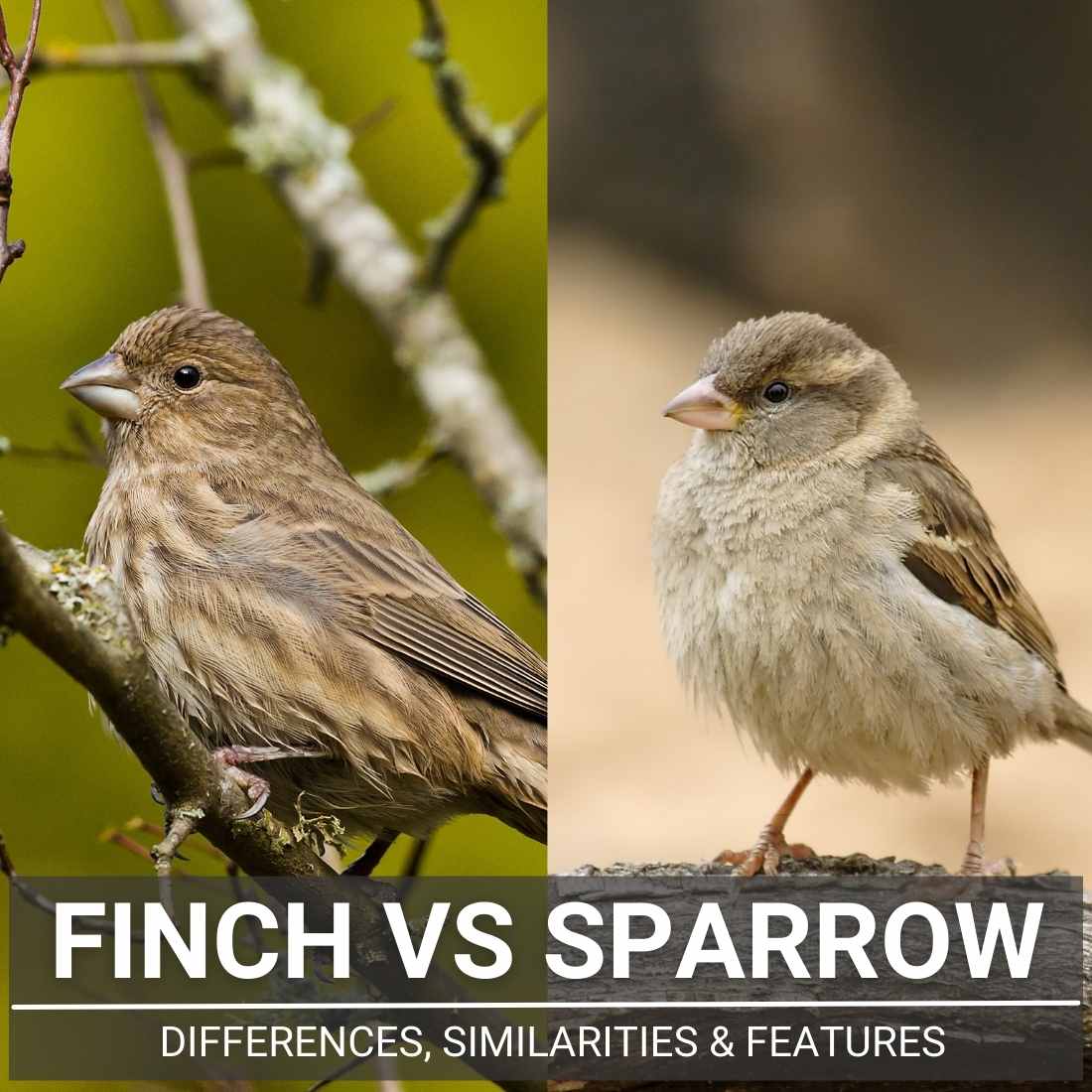Have you ever found yourself gazing at a small bird, wondering, “Is that a finch or a sparrow?” You’re not alone.
Table of Contents
These two birds can be tricky to distinguish, but with the right knowledge, you can become an expert. In essence, finches have conical beaks and vibrant colors, while sparrows are more muted with stout beaks.
But there’s so much more to uncover! Stay with us as we delve into the captivating world of finches and sparrows, revealing their unique characteristics and behaviors.
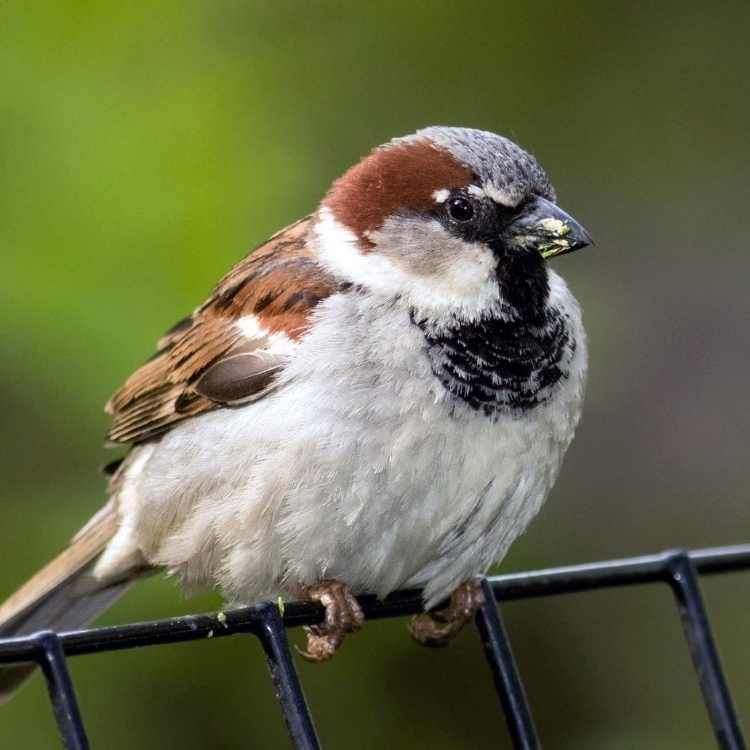
Main differences to tell them apart
| Differentiation | Finch | Sparrow |
|---|---|---|
| Overall Size | Finches are generally smaller birds, ranging from 3 to 10 inches in length. Their compact size allows them to move quickly and efficiently. | Sparrows are slightly larger, typically measuring between 4 to 7 inches. Their size can vary depending on the species. |
| Wingspan | Finches have a wingspan of about 7 to 10 inches. This allows them to maneuver easily in their habitats. | Sparrows have a wingspan that ranges from 7 to 9 inches. This aids in their flight and balance. |
| Weight | Finches are lightweight birds, usually weighing between 0.5 to 1.5 ounces. Their light weight aids in flight and seed dispersal. | Sparrows typically weigh between 0.9 to 1.4 ounces. Their weight can vary depending on their diet and habitat. |
| Body Shape | Finches have a compact and robust body shape. This shape aids in their seed-cracking diet. | Sparrows have a more streamlined and elongated body shape. This shape helps them in their varied diet and habitats. |
| Dimorphic Genders | Many finch species are sexually dimorphic, meaning males and females have different appearances. This is often seen in their coloration. | Sparrows are also often sexually dimorphic. Males usually have more vibrant plumage compared to females. |
| Coloration | Finches often display brighter colors, which can include hues of red, yellow, or green. This coloration can attract mates and signal health. | Sparrows have more muted coloration, often in shades of brown or gray. This helps them blend into their surroundings and avoid predators. |
| Patterns | Finches often have more complex patterns on their plumage. These patterns can vary greatly between species. | Sparrows typically have subtle striping on their plumage. This can help them camouflage in their habitats. |
| Plumage | Finch plumage is vibrant and can change with the seasons. This is especially noticeable in males during the breeding season. | Sparrow plumage is more subdued and can also change with the seasons. Males often have more vibrant plumage during the breeding season. |
| Eye Color | Finch eye color varies by species. Some species, like the Zebra Finch, have distinctive eye markings. | Sparrows usually have dark eye color. This can help protect their eyes from sunlight. |
| Leg Color | Finch leg color varies by species. This can range from light to dark shades. | Sparrows usually have dark leg color. This can help camouflage their legs in their habitats. |
| Leg Length | Finches have short legs. This is suitable for their perching and hopping behaviors. | Sparrows have short to medium legs. This aids in their ground foraging behaviors. |
| Bill Size and Shape | Finches have a short, robust, and conical bill. This is perfect for cracking open seeds. | Sparrows have a thinner and more delicate bill. This allows them to eat a variety of foods, including seeds and insects. |
| Tail Shape | Finch tail shape varies by species, and can be notched or forked. This aids in flight and balance. | Sparrows usually have squared or rounded tails. This helps them in flight and can be used for signaling. |
| Tail Length and Usage | Finches have short to medium tails, which are used for balance. The tail can also aid in steering during flight. | Sparrows have medium tails, which are used for balance and signaling. |
| Tail Length and Usage | Finches have short to medium tails, which are used for balance. The tail can also aid in steering during flight. | Sparrows have medium tails, which are used for balance and signaling. The tail can also be fanned out during courtship displays. |
| Flocks | Finches are more solitary or live in small groups. This can vary based on the species and the time of year. | Sparrows are often found in large flocks, especially outside of the breeding season. This social behavior can provide protection from predators. |

Overview of Finches
The finch is a bird species admired for its vibrant colors and melodious songs. There are numerous types of finches scattered across the globe, each possessing unique characteristics.
Some finches, like the Goldfinch, are known for their extraordinary beaks adapted to their specific diets, while others, such as the Zebra Finch, are recognized for their distinctive flight patterns and striking appearance.
These birds offer a captivating glimpse into the diversity of avian life, showcasing the remarkable adaptability and variety found within the finch family.
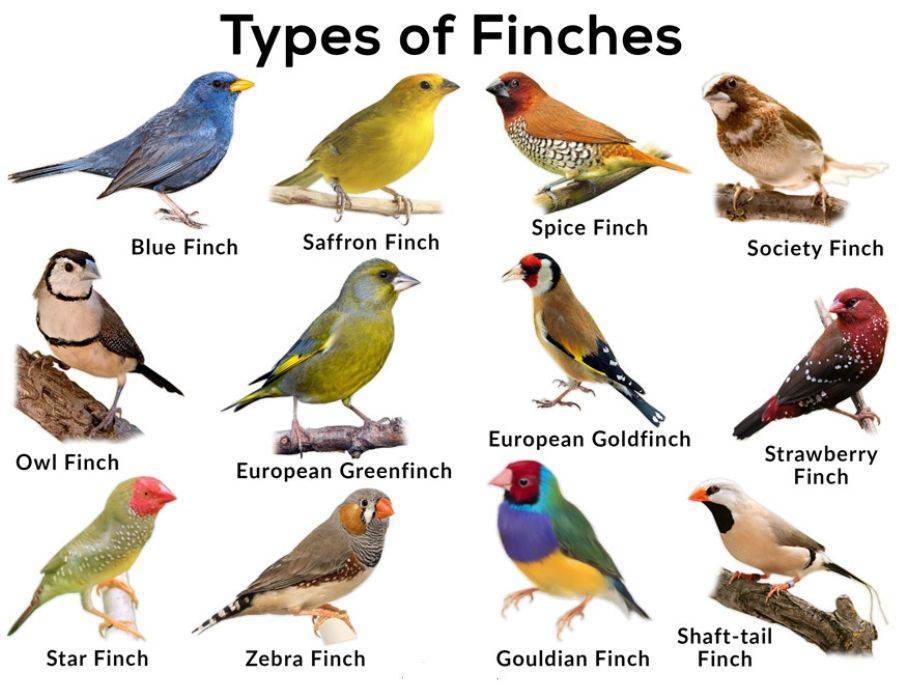
Overview of Sparrows
Contrasting the finch, the sparrow is a bird often associated with urban environments and human settlements. Despite their ubiquity, sparrows are far from ordinary.
There are various types of sparrows, each with unique traits and behaviors. The House Sparrow, for instance, is known for its adaptability and presence around human habitation, while the Song Sparrow is celebrated for its melodious and complex song.
Understanding these species helps us appreciate the intricate tapestry of bird life that surrounds us, highlighting the importance of these often overlooked birds in our ecosystems.
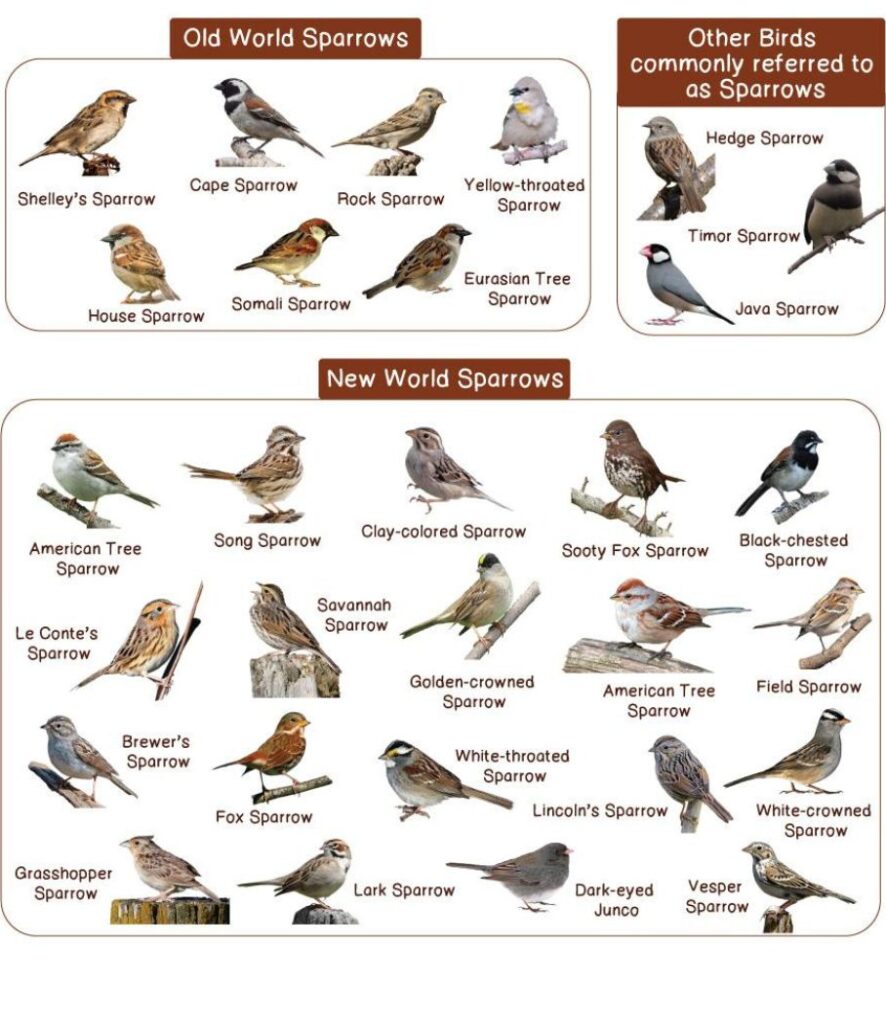
Physical Differences
Size and Body Shape
When observing finches and sparrows, one of the first differences you’ll notice is their size and body shape. Finches are generally smaller and more compact, with a robust, conical beak perfect for cracking seeds. Sparrows, on the other hand, tend to be slightly larger with a more streamlined shape.
Numbers and Descriptions:
- Finches range in size from 9.5 cm to 24 cm in length.
- Sparrows are generally larger, with sizes ranging from 11.5 cm to 18 cm.
Noteworthy Facts:
- The smallest finch, the Andean siskin, measures just 9.5 cm in length.
- Sparrows range in size from the Chestnut sparrow, which is 11.5 cm long, to the Parrot-billed sparrow, which can grow up to 18 cm.
- The beak of a finch can exert a pressure of up to 70 pounds per square inch, which is about three times the pressure a human can exert with their hands.
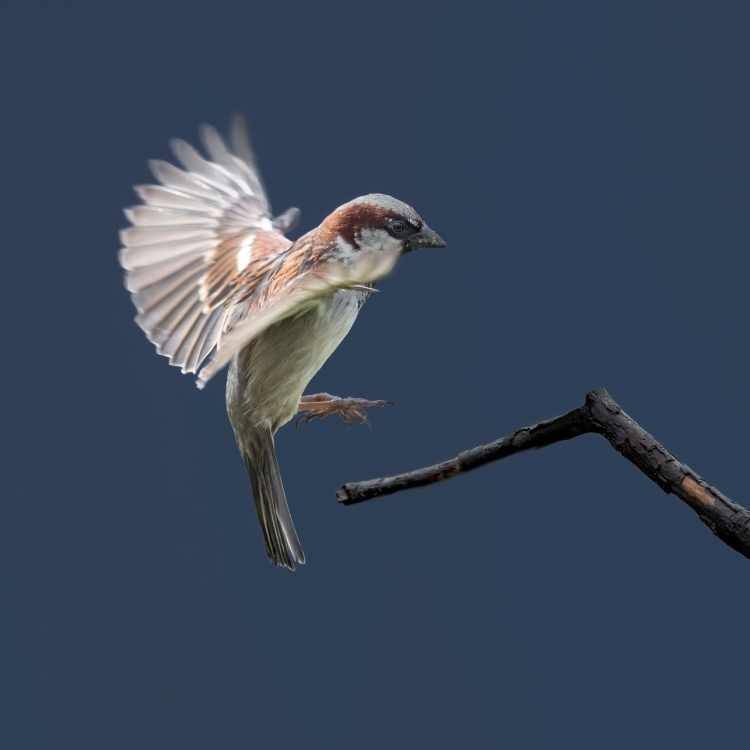
Beak Shape
The beak shape is another distinguishing feature. Finches have a strong, short beak designed for eating seeds, while sparrows have a thinner, more delicate beak.
Numbers and Descriptions:
- The beak of a finch is designed to crack open seeds.
- Sparrows have a thinner, more delicate beak suitable for a varied diet.
- The beak of a bird is made of keratin, the same material as human fingernails and hair.
Noteworthy Facts:
- The shape of a finch’s beak can indicate its diet. For example, finches with larger, stronger beaks tend to eat larger seeds.
- Some sparrows, like the Fox Sparrow, have a specialized beak that allows them to forage for insects in the ground.
- The beak of a bird is made of keratin, the same material as human fingernails and hair.
Color and Patterns
In terms of color and patterns, finches often display brighter colors and more complex patterns, while sparrows are typically more muted with subtle striping.
Numbers and Descriptions:
- Finches often display brighter colors and more complex patterns.
- Sparrows are typically more muted with subtle striping.
- The color and pattern of a bird’s plumage can serve many purposes, from attracting mates to providing camouflage.
Noteworthy Facts:
- The Gouldian Finch, native to Australia, is known for its vibrant, rainbow-colored plumage.
- The plumage of sparrows can change with the seasons. For example, the male House Sparrow has more vibrant colors in the breeding season.
- The color and pattern of a bird’s plumage can serve many purposes, from attracting mates to providing camouflage.
Behavioral Differences
Feeding Habits
When it comes to dining, finches are the vegetarians of the bird world, primarily feasting on seeds. Their strong beaks are like a built-in nutcracker, perfect for breaking open seeds. Sparrows, on the other hand, are adventurous eaters. They enjoy a more varied menu that can include insects, seeds, and berries, showcasing their adaptability and resourcefulness.
Facts:
- Finches primarily eat seeds, using their strong beaks to crack them open.
- Sparrows have a more varied diet that includes insects, seeds, and berries.
- Both finches and sparrows can adjust their diet based on the availability of food sources.
Noteworthy Facts:
- The diet of a finch can vary based on the species and the availability of food in their habitat.
- Some sparrows, like the Song Sparrow, are known to eat a large number of insects, especially during the breeding season.
- The diet of sparrows can change with the seasons, with more insects eaten in the summer and more seeds and berries in the winter.
Nesting Habits
If you were to peek inside a birdhouse, you might find a finch or a sparrow. Both are cavity nesters, but their choice of ‘real estate’ differs. Finches are the tree-dwellers, often building their cozy nests amidst the branches. Sparrows, however, are the urbanites, preferring to nest in buildings or other man-made structures, demonstrating their resilience in human-dominated landscapes.
Facts:
- Finches often build their nests in trees or shrubs.
- Sparrows prefer to nest in buildings or other man-made structures.
- Both finches and sparrows are cavity nesters, meaning they nest in enclosed spaces.
Noteworthy Facts:
- Some finches, like the Zebra Finch, are known to reuse their nests for multiple breeding seasons.
- The House Sparrow is known to nest in a variety of man-made structures, including building vents and lamp posts.
- Some sparrows, like the Eurasian Tree Sparrow, prefer to nest in tree cavities rather than man-made structures.
Social Behavior
In terms of social behavior, finches are introverts, typically leading more solitary lives or sticking to small groups. They value their space, much like a quiet person might enjoy a calm afternoon with a book. Sparrows, in contrast, are the social butterflies, often found in large, bustling flocks, embodying the phrase ‘the more, the merrier’.
Facts:
- Finches are typically more solitary or live in small groups.
- Sparrows are often found in large flocks.
- The social behavior of both finches and sparrows can vary based on the species and the time of year.
Noteworthy Facts:
- Some finches, like the Goldfinch, are known to form large flocks outside of the breeding season.
- The House Sparrow is known for its social behavior and is often found in large flocks.
- Some sparrows, like the Song Sparrow, are more solitary and defend their territory aggressively.
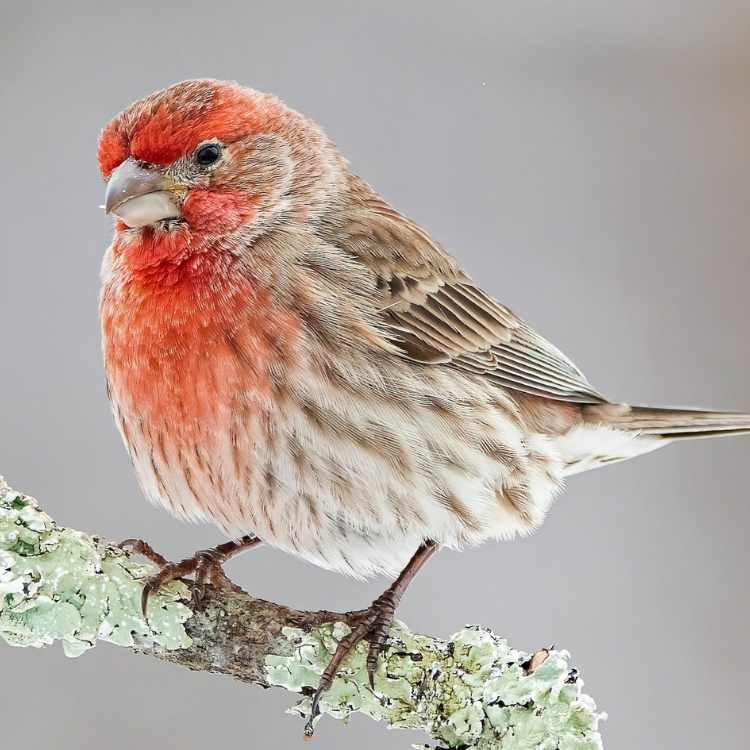
Habitat and Distribution
Common Habitats of Finches
Finches are the globetrotters of the bird world, making homes in a variety of habitats, from lush forests to arid deserts. They have a particular fondness for open habitats where seeds are plentiful, like a buffet in the wild.
If you’re keen to learn more about these adaptable avians, you can find a wealth of information about finches here.
Facts:
- Finches are found in a variety of habitats, from forests to deserts.
- They are particularly common in open habitats where seeds are abundant.
- The specific habitat preference of a finch can vary based on the species.
Noteworthy Facts:
- The Zebra Finch, native to Australia, is known to inhabit a range of habitats, from grasslands to desert regions.
- The Goldfinch, found in North America, prefers habitats with shrubs and trees, such as orchards and gardens.
- Some finches, like the Darwin’s finches of the Galapagos Islands, are known for their adaptability to different habitats.
Common Habitats of Sparrows
Sparrows, conversely, are the city slickers and country dwellers of the bird kingdom. They are often found in close association with human habitation, whether it’s the hustle and bustle of city streets or the tranquil charm of rural landscapes.
For a deeper dive into the world of sparrows, check out this comprehensive resource here.
Facts:
- Sparrows are often associated with human habitation and can be found in both rural and urban settings.
- They can adapt to a variety of habitats, from forests to grasslands.
- The specific habitat preference of a sparrow can vary based on the species.
Noteworthy Facts:
- The House Sparrow, one of the most widespread and common sparrows, is known to inhabit a variety of human-dominated habitats. They may be found in cities, playgrounds, townships, lawns, farms, gardens, and a variety of other man-made environments, as well as in the wild. Their adaptability is the fundamental reason they have been such a successful invading species in the first place.
- The Eurasian Tree Sparrow, in contrast, prefers woodland habitats and is less associated with human habitation.
- Some sparrows, like the Savannah Sparrow, are known to inhabit a range of open habitats, from grasslands to marshes.
Geographic Distribution
When it comes to geographic distribution, both finches and sparrows have stamped their passports in numerous locations worldwide. However, their specific ranges depend on the species. Some are cosmopolitan travelers, found across the globe, while others prefer to stay local, limited to certain regions.
This wide distribution reflects the remarkable adaptability and resilience of these two bird families.
Facts:
- Both finches and sparrows have a wide geographic distribution, with species found on every continent except Antarctica.
- The specific range of a finch or sparrow can vary based on the species.
- Some species are found worldwide, while others are limited to certain regions.
Noteworthy Facts:
- The House Sparrow is one of the most widely distributed bird species, found on every continent except Antarctica.
- The Goldfinch, a common finch species, is found across North America and has been introduced to other parts of the world.
- Some species, like the Eurasian Tree Sparrow, have a more limited distribution, found primarily in Europe and Asia.
Impact on the Ecosystem
Role of Finches in the Ecosystem
Finches, with their seed-loving diet, are like the gardeners of the natural world. As they feast on seeds and later disperse them, they play a crucial role in the ecosystem, helping to spread plant life far and wide.
This not only contributes to plant diversity but also promotes growth and regeneration in their habitats. It’s a bit like they’re conducting a symphony of life, with each seed sown playing a note in the harmonious melody of the ecosystem.
Role of Sparrows in the Ecosystem
Sparrows, on the other hand, are the pest controllers and architects of the bird world. With their varied diet, they help keep insect populations in check, preventing any one species from becoming too dominant. In addition, their seed-eating habits also contribute to seed dispersal, much like their finch counterparts.
Moreover, their preference for nesting in a variety of habitats, including man-made structures, can influence the structure and composition of these habitats. They subtly shape the world around them, proving that even the smallest creatures can have a big impact.
FAQ
How do you compare finch and sparrow?
Comparing a finch and a sparrow is like playing a game of spotting the difference. Look for clues in their size, body shape, beak shape, and color patterns. Finches are generally smaller with robust, conical beaks and vibrant colors.
Sparrows are slightly larger, with more delicate beaks and muted colors. Their behaviors and habitats also offer hints. Finches are primarily seed eaters and prefer natural habitats, while sparrows have a varied diet and often live close to human habitation.
Is a house sparrow actually a finch?
This is a common misconception, but no, a house sparrow is not a finch. While they share some similarities, such as being small, seed-eating birds, they belong to different families. House sparrows are part of the Passeridae family, while finches belong to the Fringillidae or Estrildidae families. So, despite the occasional identity crisis, house sparrows are definitely not finches.
Is a finch and a sparrow the same bird?
While finches and sparrows may seem similar at first glance, they are distinct species with unique characteristics. Think of them as cousins in the vast avian family tree. They share some traits, like being small and often living near humans, but they also have differences in physical characteristics, behaviors, and habitats that set them apart.
Do sparrows and finches get along?
In the wild, sparrows and finches can coexist peacefully, although they don’t necessarily interact much. They have different social behaviors, with finches being more solitary or living in small groups, and sparrows often found in large flocks. However, when it comes to shared food sources or nesting sites, there might be some competition. But generally, they each go about their bird business without too much conflict.
Conclusion and Additional Information
Conclusion
In the grand tapestry of nature, finches and sparrows each weave their own unique threads. From their physical traits like size, body shape, and color patterns, to behavioral aspects such as feeding and nesting habits, each bird sings its own tune.
Recognizing these differences enriches our understanding of these feathered friends and enhances our birdwatching experiences. So, the next time you spot a small bird, take a moment to observe – is it a finch or a sparrow?
Additional Information
For those eager to delve deeper into birdwatching, remember that patience is key. Take time to observe not just the bird’s appearance, but also its behavior and habitat. And don’t forget the importance of biodiversity.
Each bird, whether it’s a finch, a sparrow, or another species, plays a vital role in the ecosystem. By appreciating these differences and promoting biodiversity, we not only enrich our own experiences but also contribute to the health and balance of our natural world. Happy birdwatching!
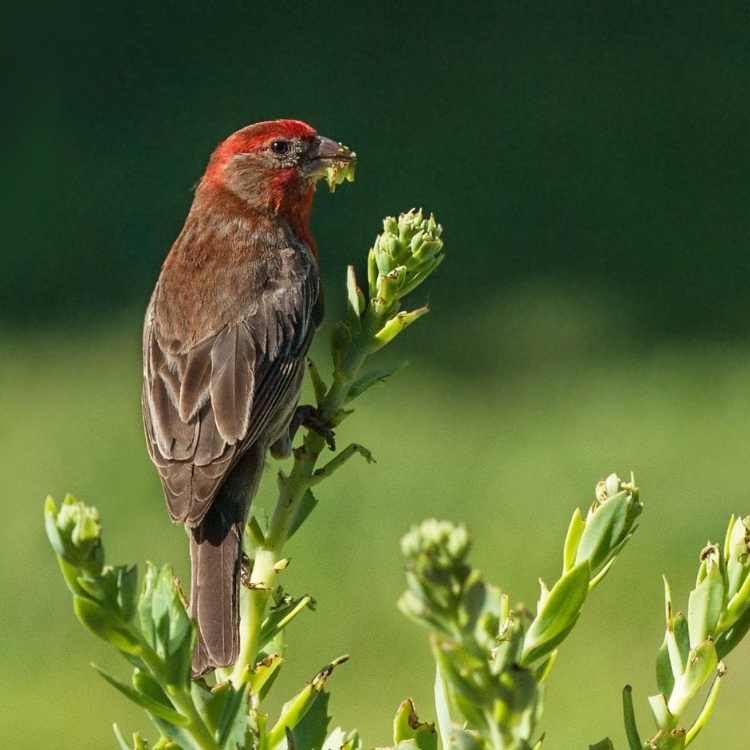
| Finch | Sparrow |
|---|---|
| Finches make sharp chip voices all day. | Sparrow produces a series of songs with cheep or chirrup notes |
| Male and females have different colors | Male and female have the same colors |
| Smaller than the Sparrow | Larger than Finch |
| Less compact than Sparrow | More compact than Finch |
| Brighter body color with huge spots of red or yellow | Subtle colors and more earthy shades |
| Finches like to eat finer/smaller seeds. For example, Nyjer seeds | Sparrows like larger seeds and grains |
| Smaller tails | Larger tails |
| Finch’s beak is smaller and slightly pointed | Sparrows have a larger and thicker beak |
| Finches have less-defined facial markings | Sparrows have well-defined facial patterns |
| The average lifespan is 16-20 years (wild) | The average lifespan is three years (wild) |
| Larger flocks | Smaller flocks |
| Have 3-4 eggs in on the clutch | Have 1-8 eggs in on the clutch |
Interesting facts about Finches
Common species of finches found in the US
- American Goldfinch (Spinus tristis)
- Purple Finch (Haemorhous purpureus)
- House Finch (Haemorhous mexicanus)
- Pine Siskin (Spinus pinus)
- Lesser Goldfinch (Spinus psaltria)
- Red Crossbill (Loxia curvirostra)
- White-winged Crossbill (Loxia leucoptera)
- Pine Grosbeak (Pinicola enucleator)
Finches are passerine bird species that are members of the Fringillidae family, which is the biggest bird family in the world. Their robust and conical beak, which are used to split open the seeds, distinguish them from the rest of the species. Here are a few more exciting Finches facts:
- Some kinds of finches eat while hanging upside down on a branch, such as Lesser Redpoll.
- The appearance of the Finch’s beak is determined by its diet, nutrition, or feeding habits.
- The Andean Siskin is considered the tiniest of all the finches.
- Also check more posts about finches: Pine Warbler vs Goldfinch, Finch Symbolism and Spiritual Meaning, the meaning of the Goldfinch, List Of Yellow Birds
Here you can check Finch sounds
Interesting facts about Sparrows
Despite the fact that sparrows are not water birds, it has been observed that they are capable of swimming underwater to travel from one location to another. So they live in diverse environments.
Common species of sparrows found in the US
- American Tree Sparrow (Spizelloides arborea)
- Chipping Sparrow (Spizella passerina)
- Field Sparrow (Spizella pusilla)
- Fox Sparrow (Passerella iliaca)
- Song Sparrow (Melospiza melodia)
- White-throated Sparrow (Zonotrichia albicollis)
- White-crowned Sparrow (Zonotrichia leucophrys)
- Dark-eyed Junco (Junco hyemalis)
Other interesting facts:
- Sparrows, unlike other birds, cannot be found in jungles or deserts, unlike other species of birds.
- Because of its friendly demeanor and propensity to dwell in flocks, the Sparrow is seen as a sign of loyalty in Japan.
- Sparrows were formerly widespread around the world, but now these little birds are on the verge of being listed as endangered.
- Also check out more posts about sparrows: Meaning of Dead Sparrow, Sparrow Symbolism, Sparrow Vs Swallow, and Sparrow Feather Meanings.
Here you can check Sparrow sounds
